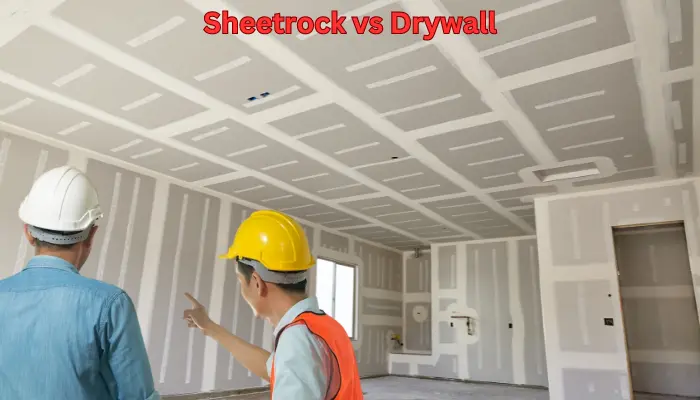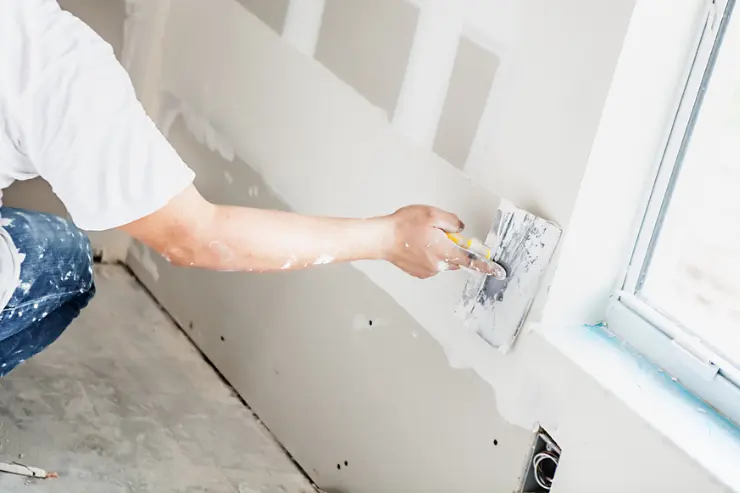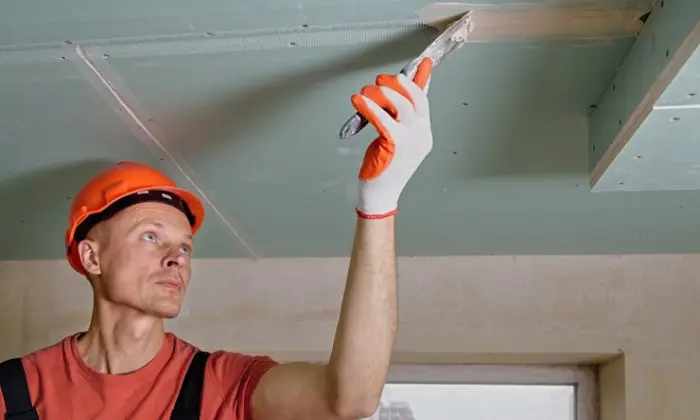When it comes to building and renovating homes, the terms ‘Sheetrock’ and ‘drywall’ are often used interchangeably. But what’s the real difference between sheetrock vs drywall? Let’s break it down.
Drywall
Drywall is a common material used in the construction of interior walls and ceilings. It consists of a gypsum core sandwiched between two layers of paper. This simple, yet effective design makes drywall a popular choice for creating smooth, even surfaces quickly and efficiently. Drywall is a type of construction where material is installed without wet plaster.
Sheetrock: A Brand of Drywall
Sheetrock is actually a brand name for a specific type of drywall. USG Corporation produces it and it is known for its quality and durability. Although “Sheetrock” is a brand name, people often use it generically to refer to drywall products in general. So, when someone says “Sheetrock,” they’re discussing a type of drywall, but not all drywall is Sheetrock.
Key Differences Between Sheetrock Vs Drywall

When discussing interior wall materials, “Sheetrock” and “drywall” are terms you’ll often hear. While they are closely related, you should be aware of some key differences. Let’s explore these differences to help you choose the best option for your project.
Sheetrock
- Sheetrock is a specific brand of drywall. One type of drywall, so every Sheetrock product is indeed drywall.
- Sheetrock is durable and reliable, making it a popular choice for various construction projects.
- Sheetrock may include specific chemical additives that enhance its performance and durability.
- USG exclusively manufactures sheetrock, ensuring a standardized product.
Drywall
- Drywall is a general term for a variety of products, and the Sheetrock brand does not make all of it. Many other brands produce drywall.
- Drywall quality can vary depending on the manufacturer, ranging from budget options to high-end products.
- Different drywall brands use different formulations and chemical compounds, so the composition can differ.
- Multiple manufacturers produce drywall, each offering their own versions and features.
Choosing the Best Option
When choosing between Sheetrock vs drywall options, consider your project’s specific needs. For a high-quality product with a reliable brand name, Sheetrock might be the best choice. For other projects, you might find suitable alternatives from different drywall manufacturers that meet your requirements and budget.
Knowing these differences can help you choose the right material for your building or renovation project. Whether you go with Sheetrock or another type of drywall, each has its advantages to offer.
What Is Drywall?

Drywall is a widely used construction material for covering the studs of interior walls and ceilings. It became the standard choice for new home construction in the mid-20th century, replacing traditional plaster. Here’s a closer look at what drywall is and why it’s so popular.
Composition and Structure
- Made from Gypsum: Drywall consists of gypsum (calcium sulfate dihydrate) pressed between two layers of thick paper. Gypsum makes drywall strong and stable, while the paper gives it a smooth surface that is ready for painting.
- Alternative Names: Drywall is also known as gypsum wallboard (GWB), wallboard, or plasterboard. People often use the terms “gypsum wallboard” and “plasterboard” interchangeably with drywall.
Usage and Benefits
- Common in Construction: Drywall is used in both commercial and residential buildings. Its ease of installation, affordability, and availability make it a popular choice.
- Variety of Types: There are different types of drywall available to meet specific needs. Moisture-resistant drywall is for damp areas, and mold-resistant drywall helps stop mold from growing.
- Fire Resistance: All drywall resists fire to some extent, but some brands provide better fire protection for extra safety.
Cost
- On average, drywall costs between $0.40 and $0.65 per square foot. The price can vary based on the type and brand of drywall.
What Is Sheetrock?
Sheetrock is a popular brand of drywall, like how “Band-Aid” is for bandages and “Kleenex” is for tissues. All Sheetrock products are drywall, but not all drywall is Sheetrock. Because of its popularity, people often use the term “Sheetrock” interchangeably with “drywall.”
Usage
Contractors use sheetrock to build walls and ceilings in homes and businesses, similar to other types of drywall.
Features
- Variety of Options: Sheetrock offers different types of drywall panels with various features. These include moisture-resistant panels, flame-resistant coatings, and sound-dampening options.
- No Sulfur Odors: Unlike some other drywall brands, Sheetrock does not emit sulfur odors. This is good because sulfur smells can be bad, cause health problems, and damage metal used in buildings.
Cost
Sheetrock costs more than other drywall brands because it is popular, offers many options, and is known for its quality.
Sheetrock is a trusted brand of drywall with a range of options to suit different construction needs. Many people choose this product because it has a reputation for high quality and no bad smells. However, it might be more expensive than other brands.
Different Types of Drywall and Sheetrock

Whiteboard (Regular Drywall)
Whiteboard, often referred to as regular drywall, is the most commonly used type of drywall in construction. People typically use it for walls and ceilings in new homes because of its ease of installation. This type of drywall comes in standard 4-by-8-foot sheets, each weighing around 50 pounds. It has a smooth surface perfect for painting and finishing, making it a great option for many indoor uses.
Soundproof Drywall
Soundproof drywall is specially designed to improve acoustic performance by adding an extra layer of viscoelastic polymer between the layers of gypsum. This additional layer significantly enhances sound dampening, making it an excellent choice for spaces where noise control is crucial. It is commonly used in home theaters, bedrooms, home offices, and music rooms where reducing noise transmission is important. This type of drywall provides superior sound isolation compared to standard drywall.
Ceiling Drywall
Ceiling drywall, also known as sag-resistant drywall, is engineered specifically for ceiling installations. It is lighter and less dense than regular drywall, which helps prevent sagging over time. This type of drywall is designed to be used in overhead applications where weight reduction is essential. Its lightweight nature makes it easier to handle and install, particularly in ceiling applications where additional support and weight management are necessary.
Moisture- and Mold-Resistant Drywall
Moisture- and mold-resistant drywall, including green board and blue board, is specially formulated to withstand high humidity and moisture levels. It features a paper backing coated with wax to repel moisture, making it ideal for use in areas prone to dampness such as bathrooms and kitchens. This type of drywall helps prevent mold growth and moisture damage, ensuring a more durable and long-lasting finish in moisture-exposed areas.
Fire-Resistant Drywall
Fire-resistant drywall, also known as fire-rated drywall, is designed to slow the spread of flames and smoke in the event of a fire. This type of drywall is commonly used in basements, garages, and other areas where fire hazards are a concern. It provides an added layer of safety by reducing the potential for fire damage and helping to contain fires within specific areas. Its fire-resistant properties make it an important consideration for safety in both residential and commercial buildings.
Pros and Cons of Drywall

Pros of Drywall
DIY-Friendly
Drywall is often considered a good choice for DIY projects. Many tasks, such as hanging and finishing drywall, can be managed by homeowners with basic tools and skills. This makes it a popular option for those looking to complete projects on their own.
Easy to Repair
One of the significant advantages of drywall is its ease of repair. If sections of drywall become damaged, they can be patched, repaired, or replaced relatively quickly and inexpensively compared to other materials like plaster or wood. This simplicity helps maintain the overall appearance of your walls and ceilings.
Paintable and Coverable
Drywall offers flexibility in design. You can easily customize its appearance by painting, wallpapering, or applying various textures and finishes. This versatility allows you to match the drywall with your home’s decor and personal style.
Affordable
Drywall is generally a cost-effective building material. While brand-name options like Sheetrock might be more expensive, drywall remains within the budget for most construction and renovation projects. Its affordability makes it accessible for a wide range of applications.
Fire-Resistant
Drywall has inherent fire-resistant properties, which help slow the spread of flames in the event of a fire. There are also special types of drywall available that offer enhanced fire protection, providing an additional layer of safety for your home or building.
Variety
Drywall comes in various types to suit different needs. Whether you require enhanced fire protection, soundproofing, moisture resistance, or lightweight options, there are specialized products available to meet your specific requirements.
Cons of Drywall
Not Waterproof or Water-Resistant
Drywall is not suitable for areas exposed to high moisture levels without additional protection. Improper installation or exposure to moisture can lead to issues such as mold, mildew, water damage, and crumbling. This makes it important to use moisture-resistant drywall in vulnerable areas.
Heavy
Drywall can be quite heavy, particularly when dealing with large sheets. Handling and installing large panels may require special equipment or additional assistance, which can make the process more cumbersome and labor-intensive.
Dusty
Cutting drywall generates a significant amount of dust, which can spread throughout the job site and create a mess. To manage this, it’s essential to contain the work area with plastic sheeting or other barriers to minimize dust contamination.
Toxicity
While most drywall is safe, imported drywall or older drywall that contains asbestos can pose health risks. It is crucial to be aware of the potential hazards, particularly when cutting or removing old drywall.
Eco-Friendliness
Drywall disposal can be an environmental concern. Most removed drywall ends up in landfills, where it may contribute to environmental harm. Studies have shown that chemicals from drywall can potentially leach into groundwater, raising ecological issues.
Drywall Sizes and Thicknesses
Drywall comes in various thicknesses and sizes to suit different applications and project needs. Choosing the right drywall thickness and size is crucial for achieving the desired results in your construction or renovation project.
Common Drywall Thicknesses
¼ Inch
Drywall that is ¼ inch thick is the thinnest option available. People primarily use it to repair existing walls, and it is particularly suitable for curved surfaces. Because of its thinness, it is more prone to breaking and offers less structural support compared to thicker drywall.
⅜ Inch
This thickness was once the standard but is now mostly used for curved walls and repairs. It offers a bit more strength than ¼ inch drywall but is not as commonly used in new construction today.
½ Inch
Drywall with a thickness of ½ inch is the most common choice for interior walls. It strikes a good balance between strength and weight, making it suitable for a wide range of applications in both residential and commercial buildings.
⅝ Inch
At ⅝ inch thick, this type of drywall is designed to reduce sagging, making it ideal for ceilings. Its increased thickness also provides enhanced fire resistance and is often used in situations where additional durability is required.
¾ Inch
The ¾ inch thick drywall is used primarily for soundproofing and provides superior noise reduction compared to thinner options. It is also used for added fire protection. Due to its thickness, it is more expensive and less common for standard wall applications.
Standard Sizes of Drywall Sheets
4 Feet by 8 Feet
This is the most common size of drywall sheets and is widely available. The 4-foot width fits well across four wall studs spaced 16 inches apart or three ceiling joists spaced 24 inches apart. The 8-foot length corresponds to the standard ceiling height in the U.S., minimizing the need for cutting during installation.
2 Feet by 2 Feet
Smaller 2-by-2 foot sheets are typically used for patches and repairs. They are convenient for fixing small areas without needing to handle larger sheets.
4 Feet by 10 Feet
These sheets are ideal for walls that are 10 feet high. They reduce the number of seams and cuts required, speeding up the installation process and providing a more seamless finish.
4 Feet by 12 Feet
For walls that reach up to 12 feet in height, 4-by-12 foot sheets are available. These larger sheets help minimize joints and cuts, making them suitable for larger spaces and high walls.
Choosing the Right Size and Thickness
When choosing drywall, consider the specific needs of your project. Determine the amount of drywall required and choose sizes that will minimize waste and simplify installation. The thickness should be based on the desired strength, insulation, and fire resistance for your walls or ceilings.
Drywall vs. Sheetrock Installation Cost
When comparing the costs of installing drywall versus Sheetrock, it’s important to understand that Sheetrock, being a high-quality brand, generally comes at a higher price. Here’s a breakdown of the cost differences and factors influencing them:
Cost Comparison
Standard Drywall: On average, standard drywall costs around $0.50 per square foot for 4-by-8-foot sheets. This price reflects the cost of generic drywall products from various manufacturers.
Sheetrock: Sheetrock, being a premium brand, costs about $0.62 per square foot for similar-sized sheets. The higher price is attributed to the brand’s reputation and quality.
Reasons for Higher Cost
- Higher-Quality Materials: Sheetrock is known for using superior materials in its products. This often results in better performance and durability, which can justify the higher cost for many users.
- Variety of Thicknesses: Sheetrock offers a broader range of thicknesses compared to generic drywall. This variety allows for more options to meet specific needs, such as enhanced soundproofing or moisture resistance.
- Manufactured in the U.S.: Sheetrock is produced by the United States Gypsum Corporation (USG), a well-established company. The domestic manufacturing contributes to higher costs, reflecting quality control and brand reliability.
- Special Features: Sheetrock provides additional features, including options for soundproofing, moisture resistance, and other specialized functions. These features add to the cost but offer enhanced performance for specific applications.
Overall, while Sheetrock may come with a higher price tag, many drywall contractors and homeowners consider it a worthwhile investment due to its quality, variety, and specialized features.
Final Thoughts
Understanding the differences between Sheetrock and drywall can help you make a more informed decision for your construction or renovation project. While Sheetrock offers high-quality materials and a trusted brand name, other drywall options may provide similar benefits at a lower cost. It’s important to consider the specific needs of your project, including budget, durability, and any specialized requirements, such as soundproofing or moisture resistance.
If you’re ready to start your project and need expert installation, ROA Drywall in Austin, Texas, is here to help. Our experienced team offers top-notch drywall services tailored to your needs. Contact ROA Drywall today for a consultation and let us bring your vision to life with the best materials and craftsmanship in the industry!